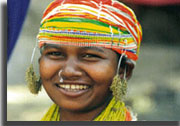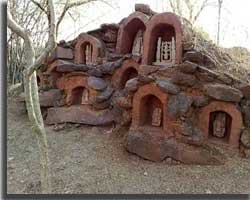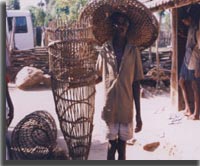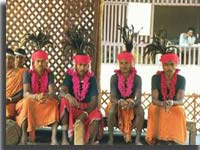History
The term Gond refers to tribal people who live all over India's Deccan Peninsula. They describe themselves as (hill people) or as Koi or Koitur. Gond Tribe Gondvana - the Mighty Kingdom in the olden days stayed from 15th century to the 18th century, this region called Gondwana was the home to the Gonds. The Gondwana Land gave its name to the present day countires like Africa, South America, Australia, India Sub Continent and Antarctica. The Gonds lost their lives in saving their lands from the upcoming tribe called the Banjaras. Scholars believe that Gonds settled in Gondwana, now known as eastern Madhya Pradesh, between the 13th and 19th centuries AD. Muslim writers described a rise of Gond state after the 14th century.

While Some Gond zamindaris (estates) survived until recently. Gonds are similar to many tribal groups today in that they face severe economic hardships. titlehough some Gond groups own a great deal of land, others are classified as Scheduled Tribes, which means they are blessed with special social and economic help from the Indian Government and the local state governments.
Origin
Gonds live all over central India i.e. in the states of Maharashtra and Odisha. Apart from Madhya Pradesh, Gonds are also found in Chattisgarh, Andhra Pradesh and Odisha. They are the largest Tribe in India, South Asia, and perhaps the world with nine million people out of which four million reside in Central India. Mostly Gonds live around the Satpura Hills, Maikala Range, Son-Deogarh uplands on the Bastar plateau and Garhjat Hills of northern Odisha.
Culture
Gonds Tribes main deity is the pantheon - a single Temple which bows to all the Gods and Culture of the World. The Clan of Gond is known as Persa Pen who protects all Clan Members. Gonds believe in the equality of the human beings without the discrimination of higher and lower society. This can be depicted throught the transparency which can be clearly seen as they themselves have inclusions of Bhils and Santals in their tribes. Mostly Gonds live in a Village with a Headman known as Mahji or Patel. The Village Council of Gond Tribe divides the Gonds into Castes called Ahir (Cowherds), Agaria (Blacksmith), Dhuli (Drummers) and Pardhan (bard and singers).

The newly wedded Gond tribes live with the elders of the family till they make a house of their own. Gonds are educated to a pretty decent level where they can understand things better. Around 25% of Gonds in Maharashtra and 15 % Gonds of Madhya Pradesh are educated. The ratio of boys to girls still remain 1: 5 percent.
Dress
Gonds tribes of India origin have a typical Indian dress culture. Men in the Gonds tribe wear Dhoti (long piece of cotton cloth wrapped around the waist passing through the legs). Women wear soft cotton saris along with the Choli or blouse.
Place /Location (then and now) |
Madhya Pradesh, Chattisgarh, Andhra Pradesh & Odisha. |
Population |
Four Million |
Languages spoken |
Gondi |
Religion/God |
Janani or the mother of creator, Pharsa Pen, Mariai- the Goddess of plague, God of household & God of fields
|
Food |
Two millets known as Kodo and Kutki and Green Leafy Vegetables |
Occupation
 | Agriculture is their main work. Gonds tribes are today mainly farmers. While some Gond communities have risen to the status of landowners, many are landless laborers. Herding cattles is a part of Gond Tribesoccupation as part of their livelihood. |
Food
The Staple Food of Gonds is two millets known as Kodo and Kutki. Vegetables are usually grown in kitchen gardens or collected from forests. Gonds grow tobacco for smoking and make liquor for Mahua tree.
Language
The prime language spoken by Gond Tribe is Gondi. Beside this, the Gond tribes have a good command on Telugu, Hindi, Marathi, Parsi and many other Dravidian languages..
Festivals

During the festivals, women wear colored glass bangles and necklaces made of small black beads. Tattooing is the major charm for Gonds. They are highly religious minded tribes of India. The Gond Indian tribes worship Janani or the mother of creator. They also worship Pharsa Pen, in the form of nail or a piece of iron chain. Mariai- the Goddess of plague and other diseases, and Bhimsen - the Hindu God are also worshiped by Gonds tribes in India. One unique feature of their beliefs is the existence of spirits.


